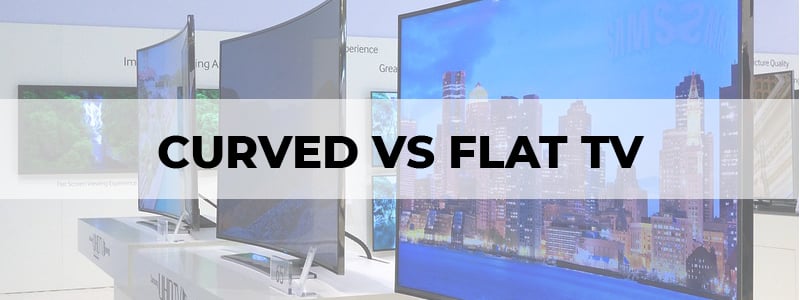
Televisions have enjoyed evolution on a level perhaps quicker and more visible than any other technology; no longer do our televisions rely on antennas, no longer do we have to bang on the TV set to get the picture right and no longer are we glued to them all the time.
Well, maybe not everything’s changed.
Still, televisions continue to get bigger and better with newer, more futuristic features, and corresponding with this rise are debates on designs: the best OLED TVs, the best smart televisions, the best televisions with digital antenna support and so on.
While flat-screen TVs are still all the rage, there’s also a discussion to be had about curved screen VS flat-screen TVs and whether these hold any merit over the other options you’d have when on the market for a new model.
What Is A Curved Screen TV?
A curved TV is exactly what the name says it is.
Curved (VS flat screen) TVs simply feature a curved panel as opposed to a flat one. Any type of TV can be curved, and a curved TV can be of any type – some of the best 75 to 80-inch TVs are curved, and some flat.
Curved projection screens, of course, have been around for nigh-on 70 years at this point, so the introduction of curved TVs in this past decade isn’t much of a surprise from an innovation angle, but the utility is as expected – the immersive IMAX experience in your living room.
Very simply, curved TVs operate (and are marketed) similar to the notion of ideal seats in a theater, with the ideal position for home television viewing being directly in front of the central point and axis, disallowing for various forms of color and picture distortion.
The manufacturers of curved TVs also claim that the glare from ambient light is minimized in such sets. Both of these have to do with the fact that the “central” view is equidistant from any given point.
Whether or not these ideas were as practical in real-life application remained to be seen, however, even as curved TV took the mid-2010s by storm, with many new models being marketed by Samsung and LG, notably.
Comparing Curved VS Flat TV
Of course, we can see a problem with the very idea behind curved TVs right off the bat. Unless you had a screen at least half the length of your wall, the experience would not come close to that of a theater. Most of us don’t think of the “curved” screen when we think of the cinema, but of the size, the sound setup, and perhaps the overall comfort level.
Additionally, some of the best TV stands only support flat-screen TVs, but this is now more a market sector-based decision than anything else. Of course, mounting them, an option that’s only been enabled in the last few couples of years, just makes the viewing angle and the television set itself, sticking out like a sore thumb as the back of the TV becomes prominent, feel awkward overall.
Yes, while the viewing immersion does increase by a certain degree, it comes with some caveats with the purported merits. There’s an issue of exaggerated reflections (not unlike the funhouse effect) being produced on a curved TV, which ends up being an inconvenience that can be very unsettling unless you somehow have zero lightings in the room.
It can also be argued that a flat TV ultimately gives a linear effect to the picture quality as the viewing angle changes, whereas on a curved TV, whichever side you’re closer to will “degrade” quickly as you move. This is especially true if you’re standing up or sitting down below the center or level with the middle, which will give the impression of the image curving up or down.
People have also reported that the difference is subtle, perhaps noticeable only by people who spend a lot of time with their television one-on-one. Of course, the size of the television is always key.
Curved TVs are also, ultimately, more expensive and “rarer” than their flat counterparts, which means it might not be a good investment if you want to sell it off later. Still, our recommendations for the best models close off this article in case you’re swayed by the next section which lists the benefits of having a curved TV.
Arguments For Buying Curved TVs
Apart from the pros and cons that are debatable at best, there are some stand-out features from a technical viewpoint in favor of curved televisions.
Firstly – and the most immediately noticeable for many – is the increased depth perception. Curving the edges forward naturally accomplishes this, but in many models (mostly Samsung), the level of possible depth enhancement processing makes for field depth to be boosted via adjusting contrast.
On that note, most curved screen televisions feature better contrast overall than their non-curved counterparts, around 1.5-1.8 times more according to reports, owing to the light being directly much more pointedly at the viewer’s eyes.
The arguments for even viewing distance are also most highlighted in the larger models with a 4200mm-radius curvature level that tracks the human eye’s naturally curved shape better (the same argument used in the cinema screen comparisons from before).
Finally, wherever the viewing angle isn’t associated with the problems we’ve already discussed, curved screens do get around the technical directionality problem of most LCD television sets where the arrays make for desaturation and low contrast the further down from the sides that you watch your TV.
